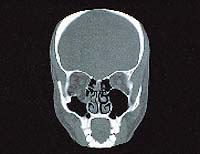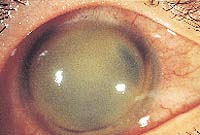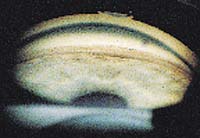Evaluate the entire orbit, check intraocular pressure in ocular trauma patients
Treatment of ocular trauma requires attention to the initial injury, the resultant inflammation and the potential for secondary problems to develop. Particular attention must be paid to potentially severe injuries, such as an orbital fracture or hyphema. Orbital fractures may compromise the sterile environment of the globe, while the settling of blood in the aqueous can result in increased intraocular pressure (IOP) and possibly a traumatic glaucoma.
In prescribing to treat these traumatic injuries, optometrists should be aware of what should and should not be administered to ease discomfort and expedite recovery.
Complete exam
 --- Racquetball injury: This CT scan of a blowout fracture of the right orbit shows the muscle entrapment incurred.
--- Racquetball injury: This CT scan of a blowout fracture of the right orbit shows the muscle entrapment incurred.
In determining how to proceed with treatment, ODs should complete a thorough exam of all the eye’s structures. Because the eye is a closed system, impact can be transmitted from the front of the eye to the back of the eye, and a retinal tear might be overlooked if the practitioner focuses solely on the cornea, Chris J. Cakanac, OD, FAAO, in private practice in North Huntington, Pa., told Primary Care Optometry News. “Check the whole system front to back. Even things as simple as checking a pupil can give you clues as to what type of damage might be present,” Dr. Cakanac said.
During the exam, special attention should be paid to the IOP, because a low measurement could indicate a penetrating injury, Leonard V. Messner, OD, FAAO, vice president for patient care services for the Illinois Eye Institute of the Illinois College of Optometry told Primary Care Optometry News.
In the event of a vitreous hemorrhage, an attempt should be made to evaluate the posterior eye grounds, usually through ultrasound, he said. If the retina can be evaluated directly, the practitioner should be looking for evidence of a retinal tear or retinal dialysis. The optic nerve should also be examined for signs of direct or indirect damage. Indirect injuries, such as shearing or compression of the optic nerve, often occur posteriorly, usually due to fracture or compression within the optical canal. The nerve head will appear normal at first, but the patient will have reduced vision.
Combination therapy
 ---Firecracker accident: This hyphema filled about half the anterior chamber with blood.
---Firecracker accident: This hyphema filled about half the anterior chamber with blood.
With trauma patients, Eric S. Bailey, OD, in private practice in St. Cloud, Minn., administers a cycloplegic agent, generally homatropine 5% or Cyclogyl (cyclopentolate, Alcon), to decrease photo phobia and decrease anterior chamber reaction. For most ocular injuries, he will treat the patient prophylactically with a topical antibiotic, Poly trim (trimethoprim sulfate, polymyxin B sulfate, Allergan) or a topical antibiotic/ steroid combination, most commonly TobraDex (tobramycin-dexamethasone, Alcon), four times daily. In conjunction with an antibiotic, he frequently prescribes a steroid as well, or chooses a combination antibiotic/steroid medication. The decision to treat using a steroid or combination antibiotic/steroid is dependent on the extent of ocular injury and risk of future inflammation.
“When I’m worried about infection, I’ll go with TobraDex and Ocuflox (ofloxacin, Allergan). Frequently, inflammation is a secondary effect of ocular trauma, and I have found clinically that if I treat with an antibiotic only, 2 days later I am dealing with a badly inflamed eye and an unhappy patient. What works best in my judgment is to treat with an antibiotic/steroid combination medication, which reduces the possibility of an inflammatory response. It has been my experience that when I don’t do this, the patient comes back within 48 hours in pain because of an inflamed eye, not necessarily an eye that has an infection. Which is worse, the punch or the swelling you get a few days later?” Dr. Bailey said.
While steroids decrease the natural immune response, most traumas are relatively sterile and if treated early do not result in active infection, he said. “The possibility of infection always exists, but, in clinical practice, when used in combination with antibiotic treatment, I have not found the use of a steroid contraindicated,” Dr. Bailey said.
To help determine the likelihood of infection, the practitioner should establish the cause of the abrasion, Dr. Messner said. Blunt injuries involving a foreign body, such as a fingernail, increase the potential for an organic pathogen to be introduced into the eye.
Oral antibiotics for orbital fractures
 --- Hyphema: The greenish yellow color of the cornea is blood staining the endothelium.
--- Hyphema: The greenish yellow color of the cornea is blood staining the endothelium.
During the exam, ODs should watch for signs of a blowout fracture, such as double vision, loss of motility or restriction of the eye muscles in different areas of gaze, Dr. Cakanac said. Any time the eye movements appears restricted, or the globe appears sunken or pushed out further than normal, a CT scan should be performed on the patient.
“I’ve ordered imaging without having any of those, just because I thought the blow was hard enough or there’s enough contusion that I’m worried about it,” Dr. Cakanac said. “One thing to remember with trauma is that it frequently leads to legal action in one way or another, so it is best to cover all bases if you have any doubt.”
When an orbital fracture is suspected, Dr. Cakanac also recommends prescribing a broad-spectrum oral antibiotic such as cephalexin or amoxicillin, taken at 250 mg four times daily for 3 days to prevent possible infection. For patients allergic to penicillin, erythromycin is a suitable alternative. “The orbit itself is a sterile environment, but the surrounding area — the sinuses — is not. If you have an orbital fracture, you have an opening for bacteria to get into the orbit,” he said.
Injuries to the lid or adnexa
 ---Fistfight: A gonio lens reveals angle recession as the result of the trauma. The dark brown band is a widening of the ciliary body at the site of the recession.
---Fistfight: A gonio lens reveals angle recession as the result of the trauma. The dark brown band is a widening of the ciliary body at the site of the recession.
Among the concerns with an injury to the lid or lid structures is the possibility of developing preseptal cellulitis, which can occur even following minor lid injuries. The most common cause of preseptal cellulitis is a primary infectious inflammatory event of the lid, such as a hordeolum, but it can occur following any type of trauma that introduces a pathogen into the lid, Dr. Messner said. This condition generally develops within a day or two after the injury, which emphasizes the need for follow-up care for several days.
When a patient has an unusual amount of pain or lid swelling, preseptal cellulitis should be suspected, and the patient should be placed on oral antibiotics, Dr. Cakanac said. In cases where it is difficult to determine if the swelling is a result of infection or the trauma, he recommends beginning the antibiotics to err on the side of caution.
Doctors also should be aware of the possibility of exposure keratitis or other surface problems that could result if the apposition of the lid to the globe is compromised, Dr. Messner said.
Trauma cases frequently involve significant bleeding, so optometrists should be equipped to handle this by having sterile gloves and material to comply with Occupational Safety and Health Administration regulations, Dr. Bailey said.
The first step is to clean the wound with sterile saline, then use ice compresses to control swelling, Dr. Bailey said. Antibiotic ointment, ranging from over-the-counter triple antibiotic ointments to ophthalmic ointments such as erythromycin or gentamicin, is then applied, and the wound is closed using butterfly bandages. The patient should then be sent to have the wound sutured. When possible, Dr. Bailey recommends referring to a plastic surgeon to improve the patient’s cosmetic outcome.
In cases of severe lacerations, Dr. Messner recommends placing a metal Fox shield to immobilize the eyelid and prevent additional damage.
Handling hyphemas
When severe trauma tears blood vessels within the eye and blood settles into the aqueous, three concerns exist: increased IOP, staining of the cornea and rebleeding. Practitioners should be aware that a hyphema cannot be evaluated strictly based on the amount of blood present, Dr. Messner said. Small hyphemas can rebleed as frequently as large ones.
Severe hyphemas may require hospitalization or bed rest. Dr. Bailey recommends considering consultation with an anterior segment specialist when any eye is more than half full of blood.
When the hyphema can be managed on an outpatient basis, the optometrist should see the patient on a daily basis, because the risk of rebleeding is highest within the first 5 days, Dr. Messner said.
“Clinicians can get lulled into a false sense of security,” he said. “If there are just a few red cells floating around and there is not much damage, they may believe they don’t have to reevaluate the patient carefully over time. That is absolutely not true. Small hyphemas have a potential to rebleed and rebleed with vigor, so you really do need to watch these patients carefully,” Dr. Messner said. For patients who are to be managed on an outpatient basis, he recommends atropine 1% one to three times a day to set the iris and the ciliary body at rest and a topical steroid to alleviate inflammation and make the patient more comfortable.
In most cases, optometrists will be able to handle the patient’s pressure without referring. Hyphemas generally resolve in about 2 weeks, and a modest pressure rise is acceptable, Dr. Cakanac said. “As long as the pressure is under 30, you don’t necessarily need to treat it because you know it is usually going to get better in 2 weeks,” he said.
When the pressure exceeds 30, beta blockers or carbonic anhydrase inhibitors should be used to lower the pressure during the early stages of the condition to prevent optic nerve damage, Dr. Cakanac said. Once the blood begins to reabsorb, the pressure should decrease, and the dosage of the pressure-lowering agent can be reduced.
After the blood has reabsorbed, the OD should look at the angle with a gonio lens to see if the trauma has caused an angle recession. Gonioscopy should not be performed until the blood is reabsorbed to avoid causing the bleeding to resume. If an angle recession has occurred, the patient will need to be placed on a glaucoma regimen to keep the IOP at acceptable levels.
A surgical consult should be obtained for a patient whose pressure averages 50 for 5 or more days and shows no sign of resolution, Dr. Messner said.
In an attempt to reduce the potential for rebleeding, which occurs in about 33% of patients within the first week, patients at the Illinois Eye Institute are placed on oral prednisone at a dosage of 0.6 mg/kg for 5 days, unless there are systemic contraindications, Dr. Messner said.
Although Dr. Bailey does not prescribe medication to prevent rebleeds, he does recommend that a patient with hyphema discontinue aspirin or other anticoagulants, in consultation with the patient’s physician.
Generally, there is little to be done about the blood in the anterior chamber except to wait for it to be reabsorbed. In cases where there is evidence of staining of the cornea, the patient should be referred for immediate surgical intervention, Dr. Messner said.
Special considerations
With black patients, optometrists should perform a sickle cell screening test, such as Sickledex, or hemoglobin electropheresis to rule out a sickle hemoglobinopathy, Dr. Messner said. Patients with this condition, which occurs in about 10% of black patients, are at risk for a more rapid IOP rise due to the “sickling” of red cells within the anterior chamber, which can impede the outflow of aqueous at the level of the trabeculum. Sickle hemoglobinopathy also may put these patients at a greater risk for subclinical small vessel disease of the optic nerve, which makes a pressure rise less tolerable.
Patients testing positive for sickle hemoglobinopathy need different medications for treating elevated IOPs. A carbonic anhydrase inhibitor, such as Diamox (acetazolamide, Lederle), will increase the level of acidosis because it reduces the pH of the eye, Dr. Messner said. This increases the likelihood of sickling of blood cells, which will impede outflow and increase the IOP. If the patient is to be placed on a carbonic anhydrase inhibitor, methazolamide is a better choice because it is less likely to lower plasma pH. Other topical agents, such as beta blockers, are also acceptable adjuvants.
For Your Information:
- Chris J. Cakanac, OD, FAAO, is in private practice in Pittsburgh and is on the associate medical staff at Jeannette District Memorial Hospital. He can be contacted at 8775 Norwin Ave., N. Huntington, PA 15642; (724) 864-7777; fax: (724) 733-5449. Dr. Cakanac has no direct financial interest in the products mentioned in this article, nor is he a paid consultant for any companies mentioned.
- Leonard V. Messner, OD, FAAO, is vice president for patient care services for the Illinois Eye Institute of the Illinois College of Optometry. Dr. Messner can be contacted at 3241 S. Michigan Ave., Chicago, IL 60616; (312) 949-7108; e-mail: lmessner@eyecare.ico.edu. Dr. Messner has no direct financial interest in the products mentioned in this article, nor is he a paid consultant for any companies mentioned.
- Eric S. Bailey, OD, can be contacted at PO Box 7654, St. Cloud, MN 56302; (320) 253-0365; fax: (320) 253-9401; e-mail: esbod@cloudnet.com. Dr. Bailey has no direct financial interest in the products mentioned in this article, nor is he a paid consultant for any companies mentioned.
